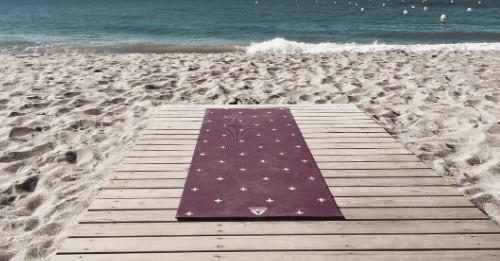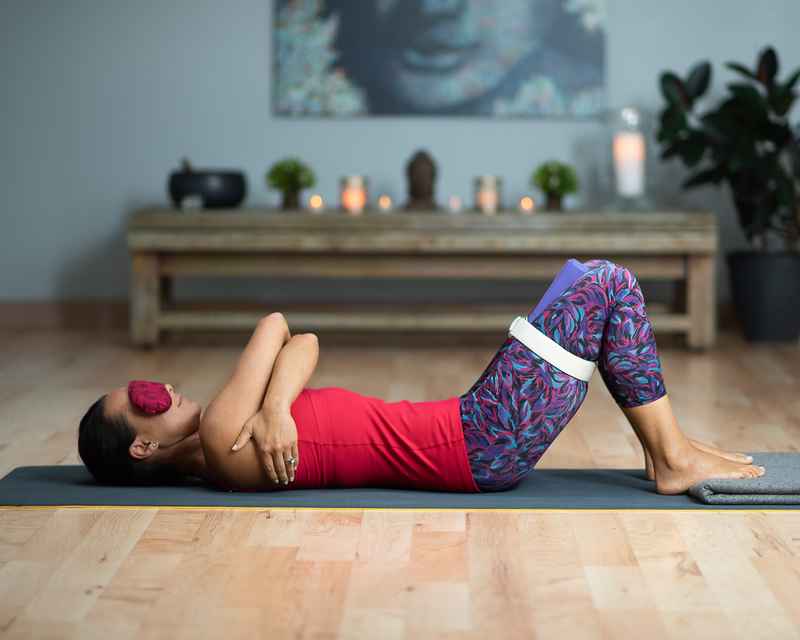Constructive Rest: Workday Power Tool

By Larissa Hall Carlson, guest contributor
If you’ve been seeking out mindful ways to reduce stress overload, but are still feeling tapped, it may be time to create space to just… do… nothing. Oh yes! There’s a stealthy workday power tool that resuscitates and revitalizes with no effort at all: meet Constructive Rest Pose.
Constructive Rest Pose is a restorative yoga posture that works like a reviving balm when time is tight and tensions are running high. Restorative yoga is known for using cozy props (e.g. blankets, cushions, eye pillows) to make poses more gentle, calming, and comfortable. This quiet, passive, meditative form of yoga encourages deep body-mind relaxation while supporting overall well-being. Unlike other styles of yoga where focus is often on movement, coordination, flexibility, strength, and balance, in restorative yoga you can expect to settle into a relaxing position and stay there for several minutes. Ah! It’s like a tranquil yoga power nap.
Good News about Doing Nothing: Yoga Research Agrees
Modern-day research is evidencing improved health and wellness benefits from the restorative yoga trend. In a randomized crossover study of Japanese nurses, Myoshi (2019) discovered that both “psychological and physical stress reactions” at work were significantly reduced by restorative yoga, and concluded that restorative yoga can be “effective for alleviating occupational stress.” That’s incredibly encouraging for those facing stressful work conditions.
Cohen, Chang, Grady, and Kanaya (2008) discovered in their pilot trial on restorative yoga that in addition to high attendance rates (great news for sustainability), adult participants showed “reduced blood pressure, a significant increase in energy levels, and trends to improvement in well-being and stress.” Similarly, research by Lapan et al (2018) showed commitment rates tend to be higher for restorative yoga than vigorous yoga. However, to attain these impressive benefits from simply lying down, it’s important to note that consistency is more important than duration—committing to a few minutes of daily restorative yoga is much more impactful than one long weekly practice.
So grab your yoga props and join the movement toward stillness! Instead of a late-afternoon cup of coffee or organic chocolate bar to get through the day, discover how simple, short, restorative postures like Constructive Rest, can help you reduce tension, relax the nerves, and calm the mind, while simultaneously rebooting energy, clarity, and presence. This is your opportunity to cultivate healthful conditions that enhance performance and support a thriving career. It’s time to get busy resting.
Try a Mindful Mini: Constructive Rest

Prepare to lay yourself down for mindful rejuvenation! During Constructive Rest Pose, the gentle binding of the legs and crossing of the arms helps melt away muscle tension while relaxing the heart space—it’s like a soothing, meditative hug. It can be practiced as a mindfulness “mini” at work or at home—boosting productivity through just 5-20 minutes of deep relaxation.
Sample this popular restorative yoga posture for reducing stress, releasing tension, recharging energy, and restoring inner peace. During this mindful-relaxation favorite, maintain either a soft, smooth, gentle breathing pattern, or allow the breath to be totally natural. This restorative pose deeply grounds and soothes.
Props: To prepare, you’ll need a mat (or rug/blanket), 1 block, a strap, an eye pillow (or washcloth), and a couple of blankets.
Potential benefits: enhanced relaxation, ease, stress relief, and rejuvenation; enhanced presence and awareness; enhanced clarity and productivity
Precautions: Although restorative yoga practices are generally considered safe, for physical or mental health concerns, check with your primary care physician before beginning this or any yoga practice. To make this posture more comfortable for those with circulation conditions, claustrophobia, or trauma sensitivities try a modified version by not strapping the legs, not crossing the arms, or not covering the eyes. If the technique creates any discomfort, discontinue immediately.
Instructions:
- Sit down on a yoga mat, blanket, or comfy rug.
- Bend your knees, placing your feet hip-width apart.
- Keep your heels on the mat and rest your forefeet on a folded blanket.
- Place a yoga block (or rolled towel) on its narrow edge between your lower thighs, then snugly secure a strap around your mid-thighs.
- *Variation without props: step feet wide apart and allow inner knees to rest against one another (see photo)
- Lay yourself down and place an eye pillow over closed eyes.
- *Variation: use a washcloth or invite the eyes to relax without props
- If you feel cold, cover up with a second blanket.
- Cross your arms comfortably over your chest.
- *Variation: place hands on the low belly and rest elbows on the floor.
- Tuck your chin slightly to lengthen the back of your neck.
- Soften and relax all the muscles in your face and jaw.
- Breathe and relax, inviting gravity to do the rejuvenating work.
- Hold for 3–5 minutes, then change the crossing of your arms and hold for another 3–5 minutes.
- Gently remove the props and release the posture
- Enjoy the soothing, relaxing, restorative effects as you head back to work refreshed!
Tip: Feeling too fidgety to relax? Try warming up beforehand with 5-10 minutes of walking meditation, mindful movements, or gentle stretches.
Prefer a Guided Relaxation? Try one of Larissa’s free relaxation or mindful movement audio tracks on Insight Timer.
Have you tried a constructive rest practice? Please share your experience below!
Coming soon: Larissa Hall Carlson is going to be a part of Mindful Leader's new mental fitness online event. Details to follow!
Larissa Hall Carlson, M.A., is a mindfulness, yoga, and Ayurveda educator with 15+ years of teaching experience at some of our country’s most prestigious institutions, including The Boston Conservatory, Cleveland Institute of Music, Nashville Ballet, Juilliard School, and Tanglewood Music Center. Larissa leads workshops and trainings around the world, with specialized coaching for musicians, artists, executives, and educators in high-performance environments. She has been featured in Elephant Journal, Men’s Journal, The Washington Post, Yoga Journal, MindBodyGreen, and Dr. Oz: The Good Life. Larissa is known for her exceptional knowledge, deep practice, and professionalism and is the creator of the new audio course Mindful Musicianship: Enhancing Optimal Performance available on Insight Timer. www.larissacarlson.com
References
Cohen, B. E., Chang, A. A., Grady, D., & Kanaya, A. M. (2008). Restorative yoga in adults with metabolic syndrome: a randomized, controlled pilot trial. Metabolic syndrome and related disorders, 6(3), 223–229. https://doi.org/10.1089/met.2008.0016
Lapen, K., Benusis, L., Pearson, S., Search, B., Coleton, M., Li, Q. S., Sjoberg, D., Konner, J., Mao, J. J., & Deng, G. (2018). A Feasibility Study of Restorative Yoga Versus Vigorous Yoga Intervention for Sedentary Breast and Ovarian Cancer Survivors. International journal of yoga therapy, 28(1), 79–85. https://doi.org/10.17761/2018-00039
Miyoshi, Y. (2019). Restorative yoga for occupational stress among Japanese female nurses working night shift: Randomized crossover trial. Journal of occupational health, 61(6), 508–516. https://doi.org/10.1002/1348-9585.12080

0 comments
Leave a comment